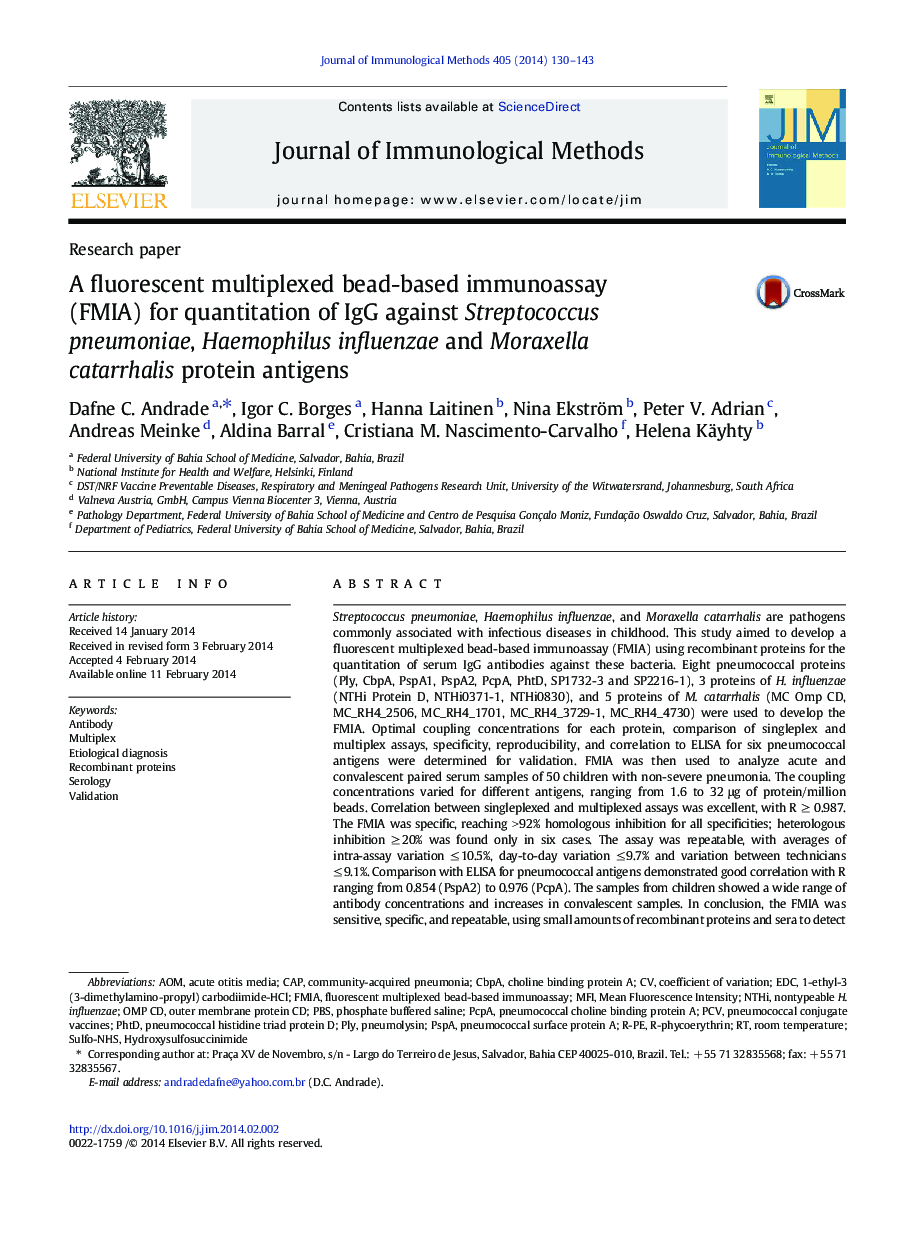| کد مقاله | کد نشریه | سال انتشار | مقاله انگلیسی | نسخه تمام متن |
|---|---|---|---|---|
| 8417797 | 1545704 | 2014 | 14 صفحه PDF | دانلود رایگان |
عنوان انگلیسی مقاله ISI
A fluorescent multiplexed bead-based immunoassay (FMIA) for quantitation of IgG against Streptococcus pneumoniae, Haemophilus influenzae and Moraxella catarrhalis protein antigens
دانلود مقاله + سفارش ترجمه
دانلود مقاله ISI انگلیسی
رایگان برای ایرانیان
کلمات کلیدی
PBSPneumococcal histidine triad protein DPhtDSulfo-NHSCbpAR-PhycoerythrinR-PEPspANTHiPCPAEDCMFIAOMValidation - اعتبار سنجیEtiological diagnosis - تشخیص بیماری شناختیRoom temperature - دمای اتاقacute otitis media - رسانه اوتیت حادSerology - سرمشناسی یا سرولوژیCoefficient of Variation - ضریب تغییرPhosphate buffered saline - فسفات بافر شورPLY - لعنتیmean fluorescence intensity - میانگین شدت فلورسانسPneumococcal conjugate vaccines - واکسن های کنگوات پنوموکوکPCV یا Pneumococcal conjugate vaccine - واکسن کونژوگه پنوموکوکAntibody - پادتَن یا آنتیبادیPneumococcal surface protein A - پروتئین سطح Pneumococcal ARecombinant proteins - پروتئین های نوترکیبPneumolysin - پنومولیسینCommunity-acquired pneumonia - پنومونی به دست آمده در جامعهmultiplex - چندگانهCaP - کلاه لبه دار
موضوعات مرتبط
علوم زیستی و بیوفناوری
بیوشیمی، ژنتیک و زیست شناسی مولکولی
بیوتکنولوژی یا زیستفناوری
پیش نمایش صفحه اول مقاله

چکیده انگلیسی
Streptococcus pneumoniae, Haemophilus influenzae, and Moraxella catarrhalis are pathogens commonly associated with infectious diseases in childhood. This study aimed to develop a fluorescent multiplexed bead-based immunoassay (FMIA) using recombinant proteins for the quantitation of serum IgG antibodies against these bacteria. Eight pneumococcal proteins (Ply, CbpA, PspA1, PspA2, PcpA, PhtD, SP1732-3 and SP2216-1), 3 proteins of H. influenzae (NTHi Protein D, NTHi0371-1, NTHi0830), and 5 proteins of M. catarrhalis (MC Omp CD, MC_RH4_2506, MC_RH4_1701, MC_RH4_3729-1, MC_RH4_4730) were used to develop the FMIA. Optimal coupling concentrations for each protein, comparison of singleplex and multiplex assays, specificity, reproducibility, and correlation to ELISA for six pneumococcal antigens were determined for validation. FMIA was then used to analyze acute and convalescent paired serum samples of 50 children with non-severe pneumonia. The coupling concentrations varied for different antigens, ranging from 1.6 to 32 μg of protein/million beads. Correlation between singleplexed and multiplexed assays was excellent, with R â¥Â 0.987. The FMIA was specific, reaching > 92% homologous inhibition for all specificities; heterologous inhibition â¥Â 20% was found only in six cases. The assay was repeatable, with averages of intra-assay variation â¤Â 10.5%, day-to-day variation â¤Â 9.7% and variation between technicians â¤Â 9.1%. Comparison with ELISA for pneumococcal antigens demonstrated good correlation with R ranging from 0.854 (PspA2) to 0.976 (PcpA). The samples from children showed a wide range of antibody concentrations and increases in convalescent samples. In conclusion, the FMIA was sensitive, specific, and repeatable, using small amounts of recombinant proteins and sera to detect antibodies against S. pneumoniae, H. influenzae and M. catarrhalis. The methodology would be suitable for studies investigating etiological diagnosis and in experimental vaccine studies.
ناشر
Database: Elsevier - ScienceDirect (ساینس دایرکت)
Journal: Journal of Immunological Methods - Volume 405, March 2014, Pages 130-143
Journal: Journal of Immunological Methods - Volume 405, March 2014, Pages 130-143
نویسندگان
Dafne C. Andrade, Igor C. Borges, Hanna Laitinen, Nina Ekström, Peter V. Adrian, Andreas Meinke, Aldina Barral, Cristiana M. Nascimento-Carvalho, Helena Käyhty,